Let me save you reading 600 words to find out what we think
– GREAT RIDE. For those of you that need more,
here’s the low down:
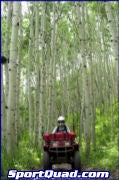 We took the 2003 Prairie 360 out for an up-close "get to know you" session in Mesa National Forest in Colorado. (Yes, in the middle of their worst wild fire emergency in history. Luckily we seemed to be in one of the few areas that remained unaffected by fire and trail closures.) For six days, we averaged about 30 miles per day, over every terrain imaginable, including dust, mud and rocks. We tried it on steep ascents and descents, long cruises on winding gravel roads, deep rutted meadows, rocky crawls over dry streambeds, and deep-water crossings. Without exception, the Prairie was a capable, reliable machine. It responded to the daily climb from camp at 6,000 feet elevation to summits of more than 9,500 feet. The highly-modified 2WD sport models riding with us suffered power loss even at camp, and their plugs were so fouled by the end of the week, one wouldn’t even start. The Prairie never sputtered, with no re-jetting.
We took the 2003 Prairie 360 out for an up-close "get to know you" session in Mesa National Forest in Colorado. (Yes, in the middle of their worst wild fire emergency in history. Luckily we seemed to be in one of the few areas that remained unaffected by fire and trail closures.) For six days, we averaged about 30 miles per day, over every terrain imaginable, including dust, mud and rocks. We tried it on steep ascents and descents, long cruises on winding gravel roads, deep rutted meadows, rocky crawls over dry streambeds, and deep-water crossings. Without exception, the Prairie was a capable, reliable machine. It responded to the daily climb from camp at 6,000 feet elevation to summits of more than 9,500 feet. The highly-modified 2WD sport models riding with us suffered power loss even at camp, and their plugs were so fouled by the end of the week, one wouldn’t even start. The Prairie never sputtered, with no re-jetting.
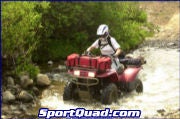 |
| Front brakes - dual hydraulic
discs; Rear brakes - sealed, oil-bathed, multi-disc. Feel free to
get them wet! |
|
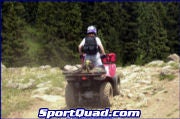 |
| Transmission -
Automatic Power-Drive System (KAPS) with KEBC™ (Kawasaki
Engine Brake Control) and high/low range, plus reverse |
|
Loaded down with three peoples’ gear each
day, the factory racks proved more than ample. With precious cargo
of chairs, fishing equipment, rain gear and lunch, it was easy to
find a balanced, secure place for everything.
The Prairie was a step-down in size (both physical frame and
engine cc) from the utility quad we had just finished a long-term
test on, so we expected a significant difference – there were
many differences, but we were pleasantly surprised. The 362cc
engine was a perfect match for the frame of the well-balanced
Prairie. (Factory specs and details) Utility
applications don’t generally call for quick starts and rapid
acceleration (generally the opposite is preferred in work
applications!), but the Prairie got up and moved out just fine
– in fact, it proved quicker accelerating and held faster at
top speed than the altitude-challenged 400cc sport quads.
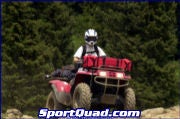 |
| Rack capacity front - 88
pounds; Rack capacity rear - 154 pounds. Load her up! |
|
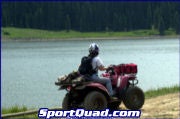 |
| Fuel capacity - 3.5 gallons.
Take it all the way to the end of the trail! |
|
We rode probably half of each day in 2WD, and
enjoyed the "sport" response and handling. When it was time to slow
down and dig in, we relied on our favorite feature – the
push-button, on the fly 4WD. Very easy to operate, even with a
gloved thumb, it clearly indicates your current operating mode. If
you find yourself losing traction on a hill climb, there is no need
to lose momentum by stopping completely – you are able to
engage the 4WD with a push of a large yellow toggle at your right
thumb. Get one wheel in the air, and it is just as easy to lock in
the front differential with a pull of a yellow lever at your right
index finger. Both are placed well – we never found an
instance where we hit either accidentally, or had to look down for
them when we did need them. They are perfectly engineered in our
opinion. Several other manufactures using push-button 4WD have
missed the mark in button placement or design – we think
Kawasaki got it just right.
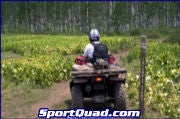 |
| Rear swingarm with
single shock, with pre-load adjustment. |
|
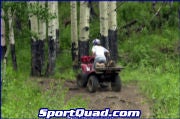 |
| Travel - 6.7 inches front, 7.0 inches rear |
|
A common handling complaint we’ve had with
other 2WD/4WD utility models, is the steering in 4WD, or lack
thereof. It’s often the case that when you engage 4WD, you
struggle with a significant loss of steering, as it may then "push"
through the corners. That was negligible on the Prairie 360, and
again, a welcome surprise. We were able to maneuver through tight
sections including steep uphills and downhills, without giving up
the traction of 4WD. This makes a ride not only more enjoyable, it
makes it safer.
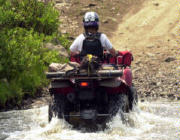 |
| Rear tires - AT25 x 10-12 tubeless |
|
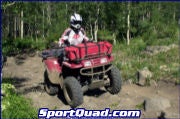 |
| Front tires - AT25 x 8-12 tubeless |
|
About the only thing we didn’t unanimously
rave about was the gas tank. Whether it is that the tank is
slightly wider, or that the seat is too narrow, where the two come
together is awkward. I found myself sitting well back on the seat
to give my knees a break, but that wasn’t practical often
because it meant both arms had to be fully extended and my weight
far back on the seat. This may be a personal preference or
body-size issue, because other test-riders in our group did not
note this as a concern.
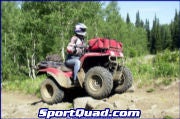 |
| Ground clearance - 7.6 inches |
|
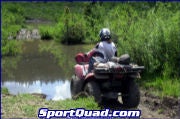 |
| Electric start with recoil backup |
|
Overall, we’d give the Kawasaki Prairie 360
high marks. It’s not a big lumbering workhorse, and
we’re certain it will prove a solid choice for a variety of
applications, entry level to advanced - besides, it provides one
heck of a fun ride.
MSRP
$5,499
Kawasaki Motors Corp., U.S.A.
PO Box 25252
Santa Ana, CA 92799-5252
Phone: 1-949-460-5688
www.Kawasaki.com
 We took the 2003 Prairie 360 out for an up-close "get to know you" session in Mesa National Forest in Colorado. (Yes, in the middle of their worst wild fire emergency in history. Luckily we seemed to be in one of the few areas that remained unaffected by fire and trail closures.) For six days, we averaged about 30 miles per day, over every terrain imaginable, including dust, mud and rocks. We tried it on steep ascents and descents, long cruises on winding gravel roads, deep rutted meadows, rocky crawls over dry streambeds, and deep-water crossings. Without exception, the Prairie was a capable, reliable machine. It responded to the daily climb from camp at 6,000 feet elevation to summits of more than 9,500 feet. The highly-modified 2WD sport models riding with us suffered power loss even at camp, and their plugs were so fouled by the end of the week, one wouldn’t even start. The Prairie never sputtered, with no re-jetting.
We took the 2003 Prairie 360 out for an up-close "get to know you" session in Mesa National Forest in Colorado. (Yes, in the middle of their worst wild fire emergency in history. Luckily we seemed to be in one of the few areas that remained unaffected by fire and trail closures.) For six days, we averaged about 30 miles per day, over every terrain imaginable, including dust, mud and rocks. We tried it on steep ascents and descents, long cruises on winding gravel roads, deep rutted meadows, rocky crawls over dry streambeds, and deep-water crossings. Without exception, the Prairie was a capable, reliable machine. It responded to the daily climb from camp at 6,000 feet elevation to summits of more than 9,500 feet. The highly-modified 2WD sport models riding with us suffered power loss even at camp, and their plugs were so fouled by the end of the week, one wouldn’t even start. The Prairie never sputtered, with no re-jetting.











 Your Privacy Choices
Your Privacy Choices